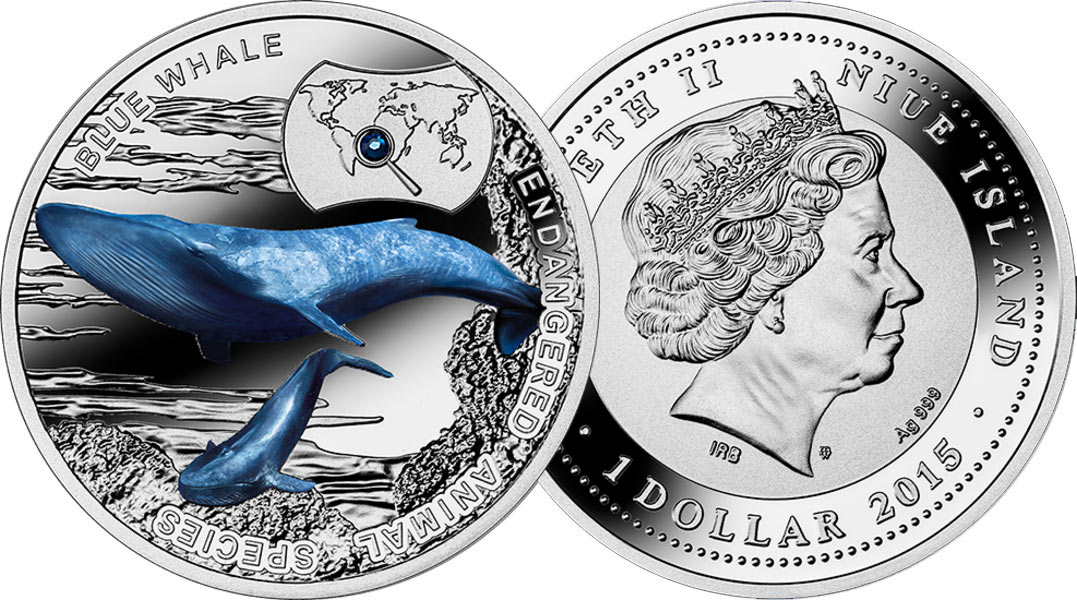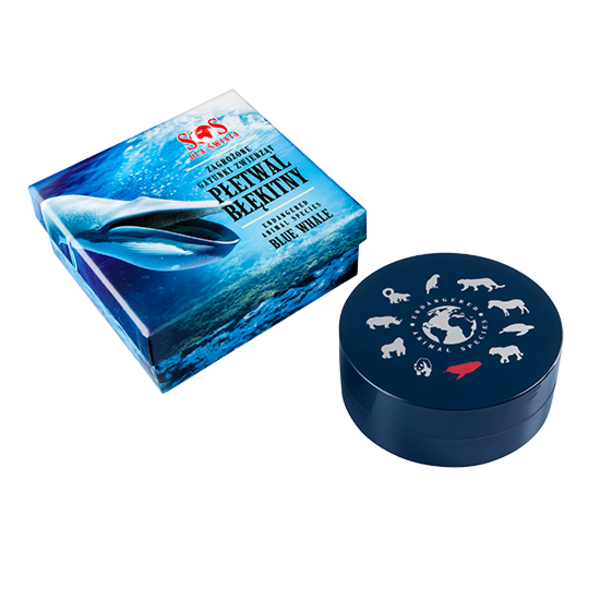The Niue-issued and Mint of Poland produced 10-coin ‘SOS Endangered Wildlife’ series of wildlife coins has reached its end with the first coin to feature an aquatic creature. After the initial release of the Hyacinth Blue Macaw and the Siberian Tiger last December, a second pair featuring the Giant Panda and the Grevys Zebra followed. A third pair depicted the Mountain Gorilla and the Black Rhinocerous back in May, after which came the Red-Ruffed Lemur in July. The Loggerhead Turtle came in September, and the last coin, the Amur Leopard, dropped in December.
 The format is the same as it’s always been, although this is the only coin to carry a 2015 date, and as a result the only one to have a mintage of 2,105 pieces. The obverse changed from the first coin, moving away from the beautiful tree of life design to the standard Queen Elizabeth II portrait. Packaging remains excellent, with a box reminiscent of the New Zealand Mints Taku/Swordfish gilded proof coin, all enclosed in a good quality and colourful shipper.
The format is the same as it’s always been, although this is the only coin to carry a 2015 date, and as a result the only one to have a mintage of 2,105 pieces. The obverse changed from the first coin, moving away from the beautiful tree of life design to the standard Queen Elizabeth II portrait. Packaging remains excellent, with a box reminiscent of the New Zealand Mints Taku/Swordfish gilded proof coin, all enclosed in a good quality and colourful shipper.
It’s a great set of ten-coins and there’s a nice box designed to hold the whole collection, although they’re quite tricky to get hold of. Selling for around the €70 mark, they’re not the cheapest half-ouncers around, but aren’t overpriced either. Also one of the few coins that manage to integrate Swarovski crystals in an unobtrusive and sympathetic way.
Most of the coins still seem to be available so it isn’t too late to get a set together. Now the series is over we’d suggest a look at the Mint of Poland’s new Fascinating Birds series, of which two have appeared to date, the first featuring the Kingfisher and the second the Hoopoe. They follow exactly the same format and cost around €70 as well.
As an aside, we usually do a featured image at top which we often play around with, but just how stunning is that Wikipedia sourced image? It seemed criminal to touch it or not to share it. Glorious animal.
The blue whale (Balaenoptera musculus) is a marine mammal belonging to the baleen whales. At 30 metres (98 ft) in length and 190 tonnes or more in weight, it is the largest existing animal and the heaviest that has ever existed, weighing over double that of the largest discovered dinosaur. It’s almost certain that Blue Whales in the time before hunting reached even greater sizes. Long and slender, the blue whale’s body can be various shades of bluish-grey dorsally and somewhat lighter underneath.
Blue whales feed almost exclusively on krill, though they also take small numbers of copepods. An adult blue whale can eat up to 40 million krill in a day. The whales always feed in the areas with the highest concentration of krill, sometimes eating up to 3,600 kilograms (7,900 lb) of krill in a single day. The daily energy requirement of an adult blue whale is in the region of 1.5 million kilocalories. The whale feeds by lunging forward at groups of krill, taking the animals and a large quantity of water into its mouth. The water is then squeezed out through the baleen plates by pressure from the ventral pouch and tongue. Once the mouth is clear of water, the remaining krill, unable to pass through the plates, are swallowed. The blue whale also incidentally consumes small fish, crustaceans and squid caught up with krill.
Blue whales were abundant in nearly all the oceans on Earth until the beginning of the twentieth century. For over a century, they were hunted almost to extinction by whalers until protected by the international community in 1966. A 2002 report estimated there were 5,000 to 12,000 blue whales worldwide, located in at least five groups. More recent research into the Pygmy subspecies suggests this may be an underestimate. Before whaling, the largest population was in the Antarctic, numbering approximately 239,000 (range 202,000 to 311,000). There remain only much smaller (around 2,000) concentrations in each of the eastern North Pacific, Antarctic, and Indian Ocean groups. There are two more groups in the North Atlantic, and at least two in the Southern Hemisphere. As of 2014, the Californian blue whale population has rebounded to nearly its pre-hunting population.
OBVERSE: In the central part of the coin – the Ian Rank-Broadley effigy of Her Majesty Queen Elizabeth II. Below – inscriptions: Ag 999 (the hallmark), m/w (the mint mark). Along the rim – inscriptions: ELIZABETH II, NIUE ISLAND (the issuer), 1 DOLLAR (the face value), and the year of issue – 2015.
REVERSE: The reverse of the coin shows images of two digitally printed Blue Whales, an adult and a calf. In the upper part of the coin – an image of a map, showing the location of occurrence of the whale. Against a map – a magnifier embedded with a SWAROVSKI ELEMENTS crystal in blue, which imitates the lens. Along the rim – inscriptions: ENDANGERED ANIMAL SPECIES (the name of the series), BLUE WHALE (the name of the coin).
| SPECIFICATION | |
|---|---|
| DENOMINATION | $1 NEW ZEALAND DOLLARS |
| COMPOSITION | 0.999 SILVER |
| WEIGHT | 17.5 g |
| SIZE | 38.61 mm |
| FINISH | PROOF |
| MINTAGE | 2,015 |
| ARTIST | T.B.C. |
| COA / BOX | YES / CUSTOM ROUND BOX IN COLOURED SHIPPER |





Leave A Comment